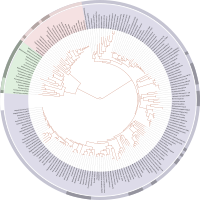
Photo from wikipedia
The need for structures capable of accommodating complex evolutionary signals such as those found in, for example, wheat has fueled research into phylogenetic networks. Such structures generalize the standard model… Click to show full abstract
The need for structures capable of accommodating complex evolutionary signals such as those found in, for example, wheat has fueled research into phylogenetic networks. Such structures generalize the standard model of a phylogenetic tree by also allowing for cycles and have been introduced in rooted and unrooted form. In contrast to phylogenetic trees or their unrooted versions, rooted phylogenetic networks are notoriously difficult to understand. To help alleviate this, recent work on them has also centered on their “uprooted” versions. By focusing on such graphs and the combinatorial concept of a split system which underpins an unrooted phylogenetic network, we show that not only can a so-called (uprooted) 1-nested network N be obtained from the Buneman graph (sometimes also called a median network) associated with the split system $$\Sigma (N)$$Σ(N) induced on the set of leaves of N but also that that graph is, in a well-defined sense, optimal. Along the way, we establish the 1-nested analogue of the fundamental “splits equivalence theorem” for phylogenetic trees and characterize maximal circular split systems.
Journal Title: Bulletin of Mathematical Biology
Year Published: 2017
Link to full text (if available)
Share on Social Media: Sign Up to like & get
recommendations!